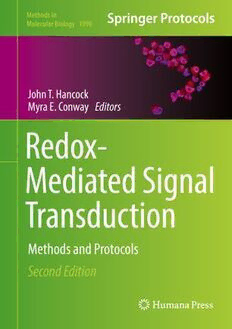
Redox-Mediated Signal Transduction: Methods and Protocols PDF
Preview Redox-Mediated Signal Transduction: Methods and Protocols
Methods in Molecular Biology 1990 John T. Hancock Myra E. Conway Editors Redox- Mediated Signal Transduction Methods and Protocols Second Edition M M B ETHODS IN OLECULAR IO LO GY SeriesEditor JohnM.Walker School of Lifeand MedicalSciences University ofHertfordshire Hatfield, Hertfordshire,AL109AB,UK Forfurther volumes: http://www.springer.com/series/7651 Redox-Mediated Signal Transduction Methods and Protocols Second Edition Edited by John T. Hancock and Myra E. Conway Department of Applied Sciences, University of the West of England, Bristol, UK Editors JohnT.Hancock MyraE.Conway DepartmentofAppliedSciences DepartmentofAppliedSciences UniversityoftheWestofEngland UniversityoftheWestofEngland Bristol,UK Bristol,UK ISSN1064-3745 ISSN1940-6029 (electronic) MethodsinMolecularBiology ISBN978-1-4939-9461-8 ISBN978-1-4939-9463-2 (eBook) https://doi.org/10.1007/978-1-4939-9463-2 ©SpringerScience+BusinessMedia,LLC,partofSpringerNature2019 Thisworkissubjecttocopyright.AllrightsarereservedbythePublisher,whetherthewholeorpartofthematerialis concerned,specificallytherightsoftranslation,reprinting,reuseofillustrations,recitation,broadcasting,reproduction onmicrofilmsorinanyotherphysicalway,andtransmissionorinformationstorageandretrieval,electronicadaptation, computersoftware,orbysimilarordissimilarmethodologynowknownorhereafterdeveloped. Theuseofgeneraldescriptivenames,registerednames,trademarks,servicemarks,etc.inthispublicationdoesnotimply, evenintheabsenceofaspecificstatement,thatsuchnamesareexemptfromtherelevantprotectivelawsandregulations andthereforefreeforgeneraluse. Thepublisher,theauthors,andtheeditorsaresafetoassumethattheadviceandinformationinthisbookarebelievedto betrueandaccurateatthedateofpublication.Neitherthepublishernortheauthorsortheeditorsgiveawarranty, expressorimplied,withrespecttothematerialcontainedhereinorforanyerrorsoromissionsthatmayhavebeenmade. Thepublisherremainsneutralwithregardtojurisdictionalclaimsinpublishedmapsandinstitutionalaffiliations. Cover Caption: Knockdown of the redox-active BCAT protein results in increased nuclear localization of MAPK in responsetoinsulin.Imagecourtesyof:MaiShafei,ArwaFlembonandDavidCorry. ThisHumanaimprintispublishedbytheregisteredcompanySpringerScience+BusinessMedia,LLC,partofSpringer Nature. Theregisteredcompanyaddressis:233SpringStreet,NewYork,NY10013,U.S.A. Preface Cellular redox reactions are fundamentally important to bioenergetics, signalling, and overallhomeostasis,yettheir assessment,particularly incells,can bechallenging.Over the lastdecade,therehasbeenadrivetodevelopmoresophisticated,sensitiveprobestobetter characterize redox modifications. This book is excellent for those who are not just new to theredoxfieldbutalsoforredoxexpertsthataimtoextendtheirresearchintonewareasor new systems. The importance of developing new methods to measure redox biology is highlighted in the opening chapter, where its role in signal transduction is defined. This chaptercoversthemainredoxcomponentsinanimalandplantcellswithafocusontherole ofreactiveoxygenspecies(ROS),reactivenitrogenspecies(RNS),andhydrogensulfidein cell signalling. This is coupled with the all-important reducing systems: thioredoxin and glutaredoxin together with the peroxiredoxins, which operate in a fine-tuned response to mainhomeostasis. Thescopeofthebookispurposelybroadtocoverawideapplicationofredoxmethods, protocols, and applications. The book first introduces the importance of working with redox compounds, in particular the delivery of these reagents. This chapter is an excellent starting point for those new in the field and gives valuable insight into the technical limitations of each redox compound. The advantages and disadvantages of each method arediscussedwithnotestoguidetheuseronthetoxicityofgasessuchasH S.Eachchapter 2 buildsonthesecompoundswherewegaininsightintothemeasurementofthesemodifica- tions using flow cytometry, ELISA assays, and Western blot analysis (using antibodies specific to 4-hydroxynonenal, S-nitrosation, and S-glutathionylation). These chapters lead nicely to recently developed probes such as the genetically encoded fluorescent probe HyPer, which has been used extensively by experts in the field. The book moves from specific protein modifications to measurement of oxidative stress in mitochondria andbiologicalsystems.Here,theimportanceofelectronparamagneticresonancespectros- copy is highlighted with a step-by-step explanation of experimental design. The detection of NO in plants is also discussed along with the challenges faced when working under hypoxic conditions. We finish the book with several chapters highlighting the broader application of these techniques, which spans from assessment of low-dose-rate ionizing radiation on redox potential to drug target identification, plant cell cycle relationships, and targeting metabolic proteomic partners, where redox active thiols are important to their function. Together these book chapters offer an exciting overview of the scope of cellular redoxanalysisandtheimportanceofnotbeinglimitedbytechnology—newmeth- odsandapplicationsarealwaysemerging. We would like to take this opportunity to sincerely thank all the authors for their contribution to this book. These authors are among leaders in their field that have con- tributed significantly to the assessment of redox cellular biology interactions. Their vision andexpertisehavecontributedtosignificantadvancesinourunderstandingofcellsignalling andnodoubtwithmoretocome.Weareatthebeginningofaveryexcitingchapterofredox v vi Preface biology. With the continued commitment to developing new and novel measurements of redox biology, we will be able to fully appreciate the extent and importance of these signallingsystemsinregulatingcellular function,inparticular withrespecttodisease. Finally, we would like to thank the series editor, John Walker, for asking us to edit thisbook. Bristol,UK JohnT.Hancock MyraE.Conway Contents Preface ..................................................................... v Contributors................................................................. ix 1 TheRoleofRedoxinSignalTransduction................................. 1 JohnT.Hancock 2 Methodsfor theAdditionofRedoxCompounds ........................... 13 JohnT.Hancock 3 InvestigatingROS,RNS,andH S-SensitiveSignalingProteins............... 27 2 EleanorWilliams,MatthewWhiteman,MarkE.Wood, IanD.Wilson,MichaelR.Ladomery,JoelAllainguillaume, TihanaTeklic,Miro Lisjak,andJohnT.Hancock 4 Measurementof4-Hydroxynonenal(4-HNE)ProteinAdducts byELISA .............................................................. 43 KoshaMehtaandVinoodB.Patel 5 UsingFlowCytometrytoDetectandMeasureIntracellular ThiolRedoxStatusinViableTCellsfromHeterogeneousPopulations........ 53 AlexJ.Wadley,RhysG.Morgan,RichardL.Darley,PaulS.Hole, andStevenJ.Coles 6 DetectionofS-NitrosationandS-GlutathionylationoftheHuman Branched-ChainAminotransferaseProteins ................................ 71 ThomasE.ForshawandMyraE.Conway 7 ImagingofIntracellularHydrogenPeroxideProduction withHyPer uponStimulationofHeLaCellswithEGF...................... 85 KseniyaN.Markvicheva,EkaterinaA.Bogdanova, DmitryB.Staroverov,SergeiLukyanov,andVsevolodV.Belousov 8 ApplicationsofElectronParamagneticResonance(EPR)Spectroscopy intheStudyofOxidativeStressinBiologicalSystems ....................... 93 SimonK.Jackson 9 ExtracellularandIntracellularNODetectioninPlants byDiaminofluoresceins.................................................. 103 NeidiqueleMariaSilveira,EduardoCarusoMachado, andRafaelVasconcelosRibeiro 10 WorkingwithHypoxia .................................................. 109 ElizabethBowlerandMichaelR.Ladomery 11 PredictingtheEffectsofLowDose-RateIonizingRadiation onRedoxPotentialinPlantCells......................................... 135 NicolCaplinandNeilWilley vii viii Contents 12 Thioredoxin-1PEGylationasanInVitroMethodforDrug TargetIdentification .................................................... 143 JolantaSkalska 13 Redox-Regulated,TargetedAffinityIsolationofNADH-Dependent ProteinInteractionswiththeBranchedChainAminotransferase Proteins ............................................................... 151 MayaE.L.HindyandMyraE.Conway 14 AnalysisofRedoxRelationshipsinthePlantCellCycle:Determination ofAscorbate,Glutathione,andPoly(ADPribose)polymerase (PARP)inPlantCellCultures............................................ 165 ChristineH.Foyer,TillK.Pellny,VittoriaLocato,JonathonHull, andLauraDeGara 15 EquationstoSupportRedoxExperimentation ............................. 183 JohnT.HancockandMatthewWhiteman Index ...................................................................... 197 Contributors JOELALLAINGUILLAUME (cid:1) FacultyofHealthandAppliedSciences,UniversityoftheWestof England,Bristol,UK VSEVOLOD V.BELOUSOV (cid:1) Shemyakin-OvchinnikovInstituteofBioorganicChemistry, Moscow,RussianFederation;PirogovRussianNationalResearchMedicalUniversity, Moscow,RussianFederation EKATERINAA.BOGDANOVA (cid:1) Shemyakin-OvchinnikovInstituteofBioorganicChemistry, Moscow,RussianFederation ELIZABETHBOWLER (cid:1) CollegeofMedicineandHealth,UniversityofExeterMedicalSchool, Exeter,UK NICOLCAPLIN (cid:1) FacultyofHealthandAppliedSciences,UniversityoftheWestofEngland, Bristol,UK STEVENJ.COLES (cid:1) SchoolofScienceandtheEnvironment,UniversityofWorcester,Worcester, UK MYRAE.CONWAY (cid:1) DepartmentofAppliedSciences,UniversityoftheWestofEngland, Bristol,UK RICHARDL.DARLEY (cid:1) InstituteofCancerandGenetics,CardiffUniversitySchoolof Medicine,Cardiff,UK LAURA DEGARA (cid:1) FacultyofBiologicalSciences,UniversityofLeeds,Leeds,UK THOMASE.FORSHAW (cid:1) FacultyofHealthandAppliedSciences,UniversityoftheWestof England,Bristol,UK CHRISTINEH.FOYER (cid:1) FacultyofBiologicalSciences,UniversityofLeeds,Leeds,UK JOHNT.HANCOCK (cid:1) DepartmentofAppliedSciences,UniversityoftheWestofEngland, Bristol,UK MAYAE.L.HINDY (cid:1) FacultyofHealthandAppliedSciences,UniversityoftheWestof England,Bristol,UK PAULS.HOLE (cid:1) InstituteofCancerandGenetics,CardiffUniversitySchoolofMedicine, Cardiff,UK JONATHON HULL (cid:1) FacultyofBiologicalSciences,UniversityofLeeds,Leeds,UK;Faculty HealthandAppliedSciences,UniversityoftheWestofEngland,Bristol,UK SIMONK.JACKSON (cid:1) FacultyofMedicineandDentistry,InstituteofTranslationaland StratifiedMedicine,SchoolofBiomedicalSciences,UniversityofPlymouth,Plymouth,UK MICHAELR.LADOMERY (cid:1) FacultyofHealthandAppliedSciences,UniversityoftheWestof England,Bristol,UK MIROLISJAK (cid:1) FacultyofAgrobiotechnicalSciences,JosipJurajStrossmayerUniversityof Osijek,Osijek,Croatia VITTORIA LOCATO (cid:1) FacultyofBiologicalSciences,UniversityofLeeds,Leeds,UK SERGEILUKYANOV (cid:1) Shemyakin-OvchinnikovInstituteofBioorganicChemistry,Moscow, RussianFederation;PirogovRussianNationalResearchMedicalUniversity,Moscow, RussianFederation EDUARDOCARUSOMACHADO (cid:1) LaboratoryofPlantPhysiology“CoaracyM.Franco”,Center R&DinEcophysiologyandBiophysics,AgronomicInstitute(IAC),Campinas,Brazil KSENIYAN.MARKVICHEVA (cid:1) Shemyakin-OvchinnikovInstituteofBioorganicChemistry, Moscow,RussianFederation ix x Contributors KOSHAMEHTA (cid:1) SchoolofAppliedSciences,LondonSouthBankUniversity,London,UK RHYSG.MORGAN (cid:1) SchoolofLifeSciences,UniversityofSussex,Brighton,UK VINOODB.PATEL (cid:1) SchoolofLifeSciences,UniversityofWestminster,Westminster,UK TILLK.PELLNY (cid:1) FacultyofBiologicalSciences,UniversityofLeeds,Leeds,UK RAFAELVASCONCELOSRIBEIRO (cid:1) LaboratoryofCropPhysiology,DepartmentofPlantBiology, InstituteofBiology,UniversityofCampinas(UNICAMP),Campinas,Brazil NEIDIQUELEMARIA SILVEIRA (cid:1) LaboratoryofPlantPhysiology“CoaracyM.Franco”,Center R&DinEcophysiologyandBiophysics,AgronomicInstitute(IAC),Campinas,Brazil JOLANTASKALSKA (cid:1) CollegeofLiberalArtsandSciences,AlfredUniversity,Alfred,NY,USA; CaptorTherapeuticsSA,Dunska,Wroclaw,Poland DMITRYB.STAROVEROV (cid:1) Shemyakin-OvchinnikovInstituteofBioorganicChemistry, Moscow,RussianFederation TIHANATEKLIC (cid:1) FacultyofAgrobiotechnicalSciences,JosipJurajStrossmayerUniversityof Osijek,Osijek,Croatia ALEXJ.WADLEY (cid:1) SchoolofSport,ExerciseandHealthSciences,LoughboroughUniversity, Loughborough,UK MATTHEWWHITEMAN (cid:1) MedicalSchoolBuilding,UniversityofExeter,Exeter,UK NEILWILLEY (cid:1) FacultyofHealthandAppliedSciences,UniversityoftheWestofEngland, Bristol,UK ELEANORWILLIAMS (cid:1) FacultyofHealthandAppliedSciences,UniversityoftheWestof England,Bristol,UK;HorizonDiscoveryLtd.,Cambridge,UK IAND.WILSON (cid:1) FacultyofHealthandAppliedSciences,UniversityoftheWestofEngland, Bristol,UK MARKE.WOOD (cid:1) GeoffreyPopeBuilding,UniversityofExeter,Exeter,UK
